388866
Brij® 93
average Mn ~357
Synonyme(s) :
Polyethylene glycol oleyl ether, Polyoxyethylene (2) oleyl ether
About This Item
Produits recommandés
Pression de vapeur
0.26 psi ( 20 °C)
Forme
liquid
Poids mol.
average Mn ~357
Indice de réfraction
n20/D 1.462 (lit.)
Densité
0.912 g/mL at 25 °C (lit.)
HLB
4
InChI
1S/C20H40O2/c1-2-3-4-5-6-7-8-9-10-11-12-13-14-15-16-17-19-22-20-18-21/h9-10,21H,2-8,11-20H2,1H3/b10-9-
Clé InChI
KWVPFECTOKLOBL-KTKRTIGZSA-N
Description générale
Informations légales
Mention d'avertissement
Warning
Mentions de danger
Conseils de prudence
Classification des risques
Aquatic Chronic 2 - Skin Irrit. 2
Code de la classe de stockage
10 - Combustible liquids
Classe de danger pour l'eau (WGK)
WGK 1
Point d'éclair (°F)
>464.0 °F - Equilibrium method
Point d'éclair (°C)
> 240 °C - Equilibrium method
Équipement de protection individuelle
Eyeshields, Gloves, type ABEK (EN14387) respirator filter
Certificats d'analyse (COA)
Recherchez un Certificats d'analyse (COA) en saisissant le numéro de lot du produit. Les numéros de lot figurent sur l'étiquette du produit après les mots "Lot" ou "Batch".
Déjà en possession de ce produit ?
Retrouvez la documentation relative aux produits que vous avez récemment achetés dans la Bibliothèque de documents.
Les clients ont également consulté
Notre équipe de scientifiques dispose d'une expérience dans tous les secteurs de la recherche, notamment en sciences de la vie, science des matériaux, synthèse chimique, chromatographie, analyse et dans de nombreux autres domaines..
Contacter notre Service technique











